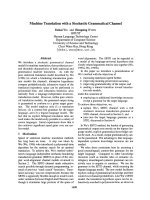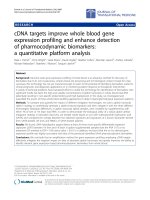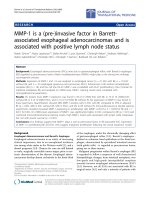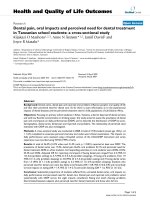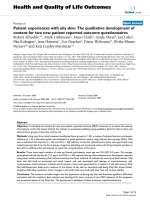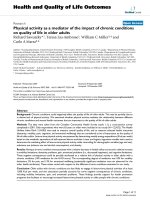báo cáo hóa học:" Force-feedback interaction with a neural oscillator model: for shared human-robot control of a virtual percussion instrument" doc
Bạn đang xem bản rút gọn của tài liệu. Xem và tải ngay bản đầy đủ của tài liệu tại đây (1.62 MB, 58 trang )
This Provisional PDF corresponds to the article as it appeared upon acceptance. Fully formatted
PDF and full text (HTML) versions will be made available soon.
Force-feedback interaction with a neural oscillator model: for shared
human-robot control of a virtual percussion instrument
EURASIP Journal on Audio, Speech, and Music Processing 2012,
2012:9 doi:10.1186/1687-4722-2012-9
Edgar J Berdahl ()
Claude Cadoz ()
Nicolas Castagne ()
ISSN 1687-4722
Article type Research
Submission date 20 April 2011
Acceptance date 8 February 2012
Publication date 8 February 2012
Article URL />This peer-reviewed article was published immediately upon acceptance. It can be downloaded,
printed and distributed freely for any purposes (see copyright notice below).
For information about publishing your research in EURASIP ASMP go to
/>For information about other SpringerOpen publications go to
EURASIP Journal on Audio,
Speech, and Music Processing
© 2012 Berdahl et al. ; licensee Springer.
This is an open access article distributed under the terms of the Creative Commons Attribution License ( />which permits unrestricted use, distribution, and reproduction in any medium, provided the original work is properly cited.
Force–feedback interaction with a neural
oscillator model: for shared human–robot
control of a virtual percussion instrument
Edgar Berdahl
∗
(), Claude Cadoz
() and Nicolas Castagn´e (nico-
)
Association pour la Cr´eation et la Recherche sur les Outils d’Expression
(ACROE) and ICA Laboratory Grenoble Institute of Technology,
46 av. F´elix Viallet, 38031 Grenoble Cedex, France
∗
Corresponding author
Abstract
A study on force–feedback interaction with a model of a neural oscillator
provides insight into enhanced human–robot interactions for controlling mu-
sical sound. We provide differential equations and discrete-time computable
equations for the core oscillator model developed by Edward Large for sim-
ulating rhythm perception. Using a mechanical analog parameterization, we
derive a force–feedback model structure that enables a human to share con-
2
trol of a virtual percussion instrument with a “robotic” neural oscillator.
A formal human subject test indicated that strong coupling (STRNG) be-
tween the force–feedback device and the neural oscillator provided subjects
with the best control. Overall, the human subjects predominantly found
the interaction to be “enjoyable” and “fun” or “entertaining.” However,
there were indications that some subjects preferred a medium-strength cou-
pling (MED), presumably because they were unaccustomed to such strong
force–feedback interaction with an external agent. With related models, test
subjects performed better when they could synchronize their input in phase
with a dominant sensory feedback modality. In contrast, subjects tended to
perform worse when an optimal strategy was to move the force–feedback
device with a 90
◦
phase lag. Our results suggest an extension of dynamic
pattern theory to force–feedback tasks. In closing, we provide an overview
of how a similar force–feedback scenario could be used in a more complex
musical robotics setting.
Keywords: force–feedback; neural oscillator; physical modeling; human–
robot interaction; new media; haptic.
3
1 Introduction
1.1 Interactive music
Although any perceivable sound can be synthesized by a digital computer
[1], most sounds are generally considered not to be musically interesting, and
many are even unpleasant to hear [2]. Hence, it can be argued that new music
composers and performers are faced with a complex control problem—out
of the unimaginably large wealth of possible sounds, they need to somehow
specify or select the sounds they desire. Historically the selection process has
been carried out using acoustic musical instruments, audio recording, direct
programming, input controllers, musical synthesizers, and combinations of
these.
One particularly engaging school of thought is that music can be cre-
ated interactively in real time. In other words, a human can manipulate
input controllers to a “virtual” computer program that synthesizes sound
according to an (often quite complicated) algorithm. The feedback from the
program influences the inputs that the human provides back to the program.
Consequently, the human is part of the feedback control loop. Figure 1 de-
picts one example, in which a human plays a virtual percussion instrument
using a virtual drumstick via an unspecified input coupling. The human
receives auditory, visual, and haptic feedback from a virtual environment
(see Figure 1). In an ideal setting, the feedback inspires the human to ex-
periment with new inputs, which cause new output feedback to be created,
for example for the purpose of creating new kinds of art [3].
4
The concept of interactive music has also been explored in the field of
musical robotics. Human musicians perform with musical instruments and
interact with robotic musicians, who also play musical instruments (not
shown). For example, Ajay Kapur has designed a robotic drummer that
automatically plays along with real human performers, such as sitar play-
ers [4]. Similarly, researchers at the Georgia Institute of Technology have
been studying how robots can be programmed to improvise live with human
musicians [5]. As the community learns how to design robots that behave
more like humans, more knowledge is created about human-computer in-
teraction, human–robot interaction, new media art, and the human motor
control system.
Our study focuses specifically on force–feedback robotic interactions.
For our purposes, it is sufficient for a human to interact with a virtual
robot as depicted in Figure 2, which simplifies the experimental setup. The
key research question motivating this particular article is, “How can we
implement shared human–robot control of a virtual percussion instrument
via a force–feedback device?” More specifically, “How can these agents be
effectively linked together (see the ? -box in Figure 2) in the context of a
simple rhythmic interaction?” The study is part of a larger research project
on studying new, extended interaction paradigms that have become possible
due to advances in force–feedback interaction technology and virtual reality
simulation [6].
5
We believe that the interaction can be more effective if the human is
able to coordinate with the virtual robot. In the human–robot interaction
literature, Ludovic et al. suggest that if robots are designed to make mo-
tions in the same ways that humans make motions, humans will be able to
coordinate more easily with the motion of the robots [7]. For this reason,
we seek to endow our virtual robot with some kind of humanlike yet very
elementary rhythm perception ability, which can be effectively employed in
a force–feedback context. There is evidence that neural oscillators are in-
volved in human rhythm perception [8], so we will use one in our model.
Future study will involve extending the virtual robot to incorporate multiple
coupled neural oscillators to enhance its abilities, but the challenge in the
present study lies in implementing high-quality force–feedback interaction
with a single neural oscillator.
It is desirable to prevent force–feedback instability in this context. One
approach is to employ mechanical analog models when designing robotic
force feedback so that the interactions preserve energy [9]. This is one reason
why our laboratory has been employing mechanical analog models since
as early as 1981 in our designs [10,11]. In the present study, we employ a
computable mechanical analog model of a neural oscillator for implementing
force–feedback interaction.
A linear-only version of the mechanical analog model was proposed ear-
lier by Claude Cadoz and Daniela Favaretto. They presented an installation
documenting the study at the Fourth International Conference on Enactive
6
Interfaces in Grenoble, France in 2007 [12]. In the present study, we relate
interaction scenarios within the framework of human–robot shared control
in Section 1, we review prior research on neural oscillators to form a basis
for the model in Section 2, we develop a mechanical analog for the “Large”
neural oscillator in Section 3, we calibrate six versions of the model and
we perform two human subject tests to evaluate them in Section 4. Finally,
following the conclusions in Section 5, the appendices provide some addi-
tional details as well as a motivating introduction into how the model can
be applied to robotic musicianship and force–feedback conducting.
2 Related evidence of neural oscillation and coordination
2.1 Perception of rhythm
The reaction time of the human motor system lies approximately in the
range 120–180 ms [13]; however, by predicting the times of future events,
humans are able to synchronize their motor control systems to external pe-
riodic stimuli with much greater temporal accuracy, for example as is nec-
essary during musical performance or team rowing. Humans can even track
rhythms despite changes in tempo, perturbations, and complex syncopation,
and humans can maintain a pulse even after the external stimulus ceases
[14]. Brain imaging studies reveal neural correlates of rhythm perception in
the brain. In particular, musical rhythms trigger bursts of high-frequency
neural activity [8].
7
2.2 Central pattern generators (CPGs) for locomotion
Animals operate their muscles in rhythmic patterns for fundamental tasks
such as breathing and chewing and also for more strongly environment-
dependent tasks such as locomotion. Neural circuits responsible for gener-
ating these patterns are referred to as central pattern generators (CPGs)
and can operate without rhythmic input. The CPGs located in the spines of
vertebrates produce basic rhythmic patterns, while parameters for adjust-
ing these patterns are received from higher-level centers such as the motor
cortex, cerebellum, and basal ganglia [15]. This explains why, with some
training, a cat’s hind legs can walk on a treadmill with an almost normal
gait pattern after the spine has been cut [16]. In fact, the gait pattern (for
instance, run vs. walk) of the hind legs can be caused to change depending
on the speed of the treadmill for decerebrated cats [17].
Similar experiments have been carried out with other animals. However,
it should be noted that in reality, higher cognitive levels do play a role
in carrying out periodic tasks [18]. For example, humans do not exhibit
locomotion after the spine has been cut—it is argued that the cerebrum
may be more dominant compared to the spine in humans compared to cats
[17]. Nonetheless, in some animals, the CPG appears to be so fundamental
that gait transitions can be induced via electrical stimulation [15].
CPGs can be modeled for simulating locomotion of vertebrates and con-
trolling robots. Figure 3 depicts a model of a Salamander robot with a CPG
consisting of ten neural oscillators, each controlling one joint during loco-
8
motion. The figure presents one intriguing scenario that could someday be
realized in multiple degree-of-freedom extensions of this study. Imagine if
a human could interact using force–feedback with the state variables of a
Salamander robot CPG. For example, in an artistic setting, the motion of
the joints could be sonified, while a live human could interact with the
model to change the speed of its motion, change the direction, and or gait
form.
2.3 Motor coordination in animals
CPGs could also provide insight into motor coordination in animals. For
example, humans tend to coordinate the movement of both of the hands,
even if unintended. Bimanual tasks which do not involve basic coordination
of the limbs tend to be more difficult to carry out, such as
• patting the head with one hand while rubbing the stomach in a circle
with the other hand, or
• performing musical polyrhythms [13], such as playing five evenly spaced
beats with one hand while playing three evenly spaced beats with the
other hand.
Unintended coordinations can also be asymmetric. For example, humans
tend to write their name more smoothly in a mirror image with the non-
dominant hand if the dominant hand is synchronously writing the name
forwards [13].
9
The theory of dynamic patterns suggests that during continuous motion,
the motor control system state evolves over time in search of stable patterns.
Even without knowledge of the state evolution of microscopic quantities,
more readily observable macroscopic quantities can clearly affect the sta-
bility of certain patterns. When a macroscopic parameter change causes
an employed pattern to become unstable, the motor control system can be
thought to evolve according to a self-organized process to find a new stable
pattern [13].
For example, consider the large number of microscopic variables nec-
essary to describe the state evolution of a quadruped in locomotion. Gait
patterns such as trot, canter, and gallop differ significantly; however, the
macroscopic speed parameter clearly affects the stability of these patterns.
For example, at low speeds, trotting is the most stable, and at high speeds
galloping is the most stable [13].
Dynamic patterns in human index finger motion can be similarly an-
alyzed. For example, Haken, Kelso, and Bunz describe dynamic patterns
made by test subjects when asked to oscillate the two index fingers back
and forth simultaneously. At low frequencies, both the symmetric (0
◦
) and
anti-symmetric (180
◦
) patterns appear to be stable. However, at higher
frequencies, the symmetric (0
◦
) pattern becomes significantly more stable.
As a consequence, when subjects begin making the anti-symmetric (180
◦
)
pattern at low frequencies, they eventually spontaneously switch to the sym-
metric (0
◦
) pattern after being asked to gradually increase the frequency of
10
the oscillation. Thus, the frequency of oscillation is a macroscopic parame-
ter [19]. The theory of dynamic patterns can also be employed to describe
human coordination with external agents, which we describe next.
2.4 Coordination with external agents
2.4.1 Unintended coordination Humans tend to coordinate motion au-
tomatically with external agents, even when not intended. For example,
pairs of test subjects completing rhythmic tasks were found to coordinate
with one another when provided with visual information about each oth-
ers’ movements despite being given no instructions to coordinate. Subjects
showed some tendency toward moving in either a 0
◦
or 180
◦
phase relation-
ship [20]. In fact, even when explicitly instructed not to coordinate, test
subject pairs still showed a statistical tendency toward 0
◦
phase-alignment
of arm motions [21].
Unintended interpersonal coordination is related to the theory of motor
resonance. This theory argues that similar parts of the brain are activated
when a human makes a movement as when an external agent makes the
same movement [7,22]. Motor resonance could also be involved with social
behaviors such as the chameleon effect, which describes the
“nonconscious mimicry of the postures, mannerisms, facial expres-
sions, and other behaviors of one’s interaction partners, such that
one’s behavior passively and unintentionally changes to match that
of others in one’s current social environment [23].”
11
There are some indications that the strength of motor resonance may de-
pend on whether the external agent is perceived to be more or less human
[24]. Consequently, Marin et al. argue that the motor response of humanoid
robots should mimic that of humans to promote bidirectional unintentional
motor coordination between robots and humans [7]. We assume a similar
approach in Sections 3 and 4, where we design a force feedback system for
coordinating with a human.
2.4.2 Intended coordination Of course interpersonal coordinations can
also be intended. Many researchers seek to fit dynamical models to human
coordination of simple motor tasks. In the case of bidirectional interpersonal
coordination between two humans swinging pendulums, a neuro-mechanical
dynamical model can be fit to the performance of participants, which shows
that participants meet both in phase and at a frequency which lies in be-
tween their own natural frequencies [25].
We briefly point out how that model could be adopted to this article’s
context. Figure 4 depicts two humans playing percussion instruments with
drumsticks. Because they coordinate their motions using auditory, visual,
and haptic feedback (not shown), the humans behave as if a weak cou-
pling spring were effectively connected between their drumsticks to exert a
synchronizing influence (see Figure 4).
12
3 Neural oscillator model
3.1 The Large oscillator
In the present study, we employ the “Large” neural oscillator introduced to
the literature by Edward Large [26]. With no inputs, the Large oscillator in
its most basic nonlinear form can be written as the following [26]:
˙
z = z(α + iω + b|z|
2
) (1)
The variable z(t) ∈ C rotates about the origin of the complex plane at
radial frequency ω ∈ R. The damping parameter α ∈ R is chosen positive
to cause the equilibrium point at the origin of the complex plane to be
unstable, so that when subjected to some perturbations, the Large oscillator
will self-oscillate.
The parameter b ∈ R causes the system to tend to a limit cycle with
magnitude r
lim
=
−α/b for b < 0 as can be shown by transforming into
polar coordinates using the identity z(t) = r(t)e
iφ(t)
. The system can then
be decoupled into the following two independent differential equations [26]:
˙r = r(α + br
2
) (2)
and
˙
φ = ω. (3)
More complex terms can also be incorporated into (1), for which the non-
linear differential equation can also be separated into two real parts, but
this more complicated work is not necessary for the present study [27].
13
Because the phase, as described by (3), evolves independently of the
amplitude (see (2)), the output position of the Large oscillator tends to
be approximately sinusoidal, even if the amplitude is changing relatively
quickly. This characteristic is especially useful for our musical application
as explained in Appendix C. In contrast, many other commonly employed
neural oscillator models have a complex interaction between the magnitude
and phase [19,25,28,29]. Furthermore, we employ the Large oscillator in
this study also because it is a key part of a model for human perception
of rhythm [26], implying that a robot incorporating Large oscillators could
theoretically perceive rhythm similarly to a human.
3.2 Mechanical analog of Large oscillator
In order to facilitate robust force–feedback interaction with the Large os-
cillator, we obtain mechanical analog parameters for it. The easiest way to
do so is to temporarily linearize the Large oscillator by setting b = 0 and
relating its differential equation to the following differential equation for a
damped harmonic oscillator:
m
D
¨w + R ˙w + kw = F
ext
, (4)
with mass m
D
in kg, stiffness k in N/m, and damping R in N/(m/s), with
an external force F
ext
in Newtons acting on the mass.
Then for the Large oscillator, we incorporate a general input term x ∈ C:
˙
z = z(α + iω) + x. (5)
14
By separating the equation into its real w ∈ R and imaginary u ∈ R parts
such that z = w + iu and x = x
1
+ ix
2
, we can write
˙w = αw − ωu + x
1
(6)
˙u = αu + ωw + x
2
, (7)
which results in the following after taking the derivative of both sides of (6)
and substituting using (7):
m
D
¨w − 2αm ˙w + m(α
2
+ ω
2
)w = m
D
( ˙x
1
− αx
1
− ωx
2
), (8)
where we have also multiplied both sides by the virtual mass m
D
.
Comparing with (4), we have that the equivalent mass is m
D
, the equiv-
alent damping R = −2αm
D
, and the equivalent stiffness k = (α
2
+ ω
2
).
F
ext
can be implemented by choosing inputs x
1
and x
2
such that m
D
( ˙x
1
−
αx
1
− ωx
2
) = F
ext
.
3.3 Force–feedback interaction
We focus now on designing the lowest-order virtual model that can provide
a human with high quality force, auditory, and visual feedback. The sim-
plest design involves making the virtual robot incorporate only one neural
oscillator—in this case, the robot is the neural oscillator.
Then for simplicity, the drumstick can either be connected directly to
the human or to the neural oscillator. For stability reasons, it is easier
to connect the drumstick directly to the neural oscillator. In this case, a
15
virtual spring k
C
can be employed to limit the impedance presented to
the human [30]. Simultaneously, the spring k
C
couples the human to the
neural oscillator in the same spirit as shown in Figure 4, which we believe
should promote the ability to coordinate and share control. The derived
model structure is depicted in Figure 5, drawn to emphasize the fact that the
elements are assumed to move only vertically for the purpose of conducting
simple experiments.
4 Evaluation of the interaction using subject tests
We conducted two formal subject tests in order to evaluate how effectively
human subjects could share control of the virtual percussion instrument.
4.1 Setup
Each subject gripped a single degree-of-freedom force–feedback device that
moved vertically as represented in Figure 5. The subject heard the vibra-
tion of the virtual percussion instrument and saw the position of the force–
feedback device, the neural oscillator, and the virtual percussion instru-
ment on a screen. The virtual musical instrument consisted of a simple
damped resonator. The instrument sounded once per oscillation period as
the drumstick passed through the center position moving in the negative
direction. The CORDIS-ANIMA formalism and the ERGOS platform and
force–feedback device were employed [11,31–33]. For any reader who may
wish to implement the model, we provide in Appendix A explicit discrete-
16
time equations for simulation of the Large oscillator within the CORDIS-
ANIMA paradigm.
4.2 Quantitative subject test with the linearized Large oscillator
4.2.1 Design The model structure incorporated many parameters, so we
performed a quantitative human subject test to help determine how effective
models should be adjusted. During this stage, we focused on the following
research questions:
• Does force feedback provide the subject with better control over the
oscillator?
• Is it necessary for the spring k
C
to be so strong that the oscillator and
the force–feedback device remain in phase?
• When rendering visual feedback, is it necessarily optimal to plot the posi-
tions of the force–feedback device and the oscillator, as would be the case
with real-world “physical” force–feedback interaction with a haptic-rate
resonator? Or could some other visual representation be more helpful
for the subjects?
These questions did not target specifically the neural oscillator but more
generally the whole setup at hand. Hence, for the sake of simplicity in the
first subject test, we employed a linearized version of the neural oscillator,
that is a simple oscillator obtained using the same model structure and
applying b = α = 0.
17
We found informally that it was generally easy to increase the amplitude
of the oscillation, and it was often relatively easy to speed up the oscillator
or slow it down, but it tended to be more difficult to decrease the amplitude
or stop the oscillator. For this reason, we decided to study how well a subject
could coordinate with the neural oscillator’s motion in such a manner as to
stop it, showing evidence of truly sharing control with it in all interaction
modes. In particular, we focused on the situation in which the oscillator
was started from the home position with an initial negative velocity, and
the subject was asked to try to stop the output sound in as few oscillation
“bounces” as possible. To promote high-fidelity force–feedback interaction,
the unloaded natural frequency of the neural oscillator was set to a haptic
rate of ω = 5.0 rad/sec, corresponding to about 0.8 Hz.
First Four Models
We calibrated five different models, for which we planned to later estimate
and compare their “intrinsic difficulties” relating to stopping the oscillator.
The first four models differed only in the implementation of k
C
, allowing
to adjust how strong the force–feedback link between the force–feedback
device and oscillator was. k
C
ranged from a small but non-negligible value
for WEAK, to a medium-sized value for MED, to large enough to force
the device and oscillator position to remain phase-locked for the STRNG
“strong” model. Figures 6, 7, and 8 provide some intuition into how the
positions of the force–feedback device and of the neural oscillator influence
18
each other, ranging from the WEAK model, to the MED “medium” model,
to the STRNG model. The plots are shown only for subject two, but the
coupling affected all of the subjects in the same manner. In the NF “no
force–feedback” model, k
C
had the same value as MED except that the
force–feedback was disabled.
Fifth Model NF–HINT
The fifth model was somewhat different. We included it to study how a
visual cue providing a strategy could help the subject perform the task
better given weak or non-existent force feedback, where the positions of the
force–feedback device and the oscillator might not be well correlated.
In the following analysis, we assumed that the force–feedback device
would move according to a decaying sinusoid at ω rad/sec. Even though no
test subject produced this trajectory perfectly, many were similar, and the
assumption allowed for a simple analysis that provided important insight
into the optimal phase relationship. When force feedback is sufficiently weak
(e.g., for the NF and WEAK models), then because the “spring” force on
the neural oscillator is proportional to the difference in between its posi-
tion and the position of the force–feedback device, the most energy-efficient
strategy for stopping the oscillations the fastest is for the test subject to
force the device along a position trajectory that lags that of the neural
oscillator’s position by 90
◦
. However, according to the theory of dynamic
19
patterns, a 90
◦
visual phase relationship should be difficult for test subjects
to maintain because it is considered “unstable” (see Section 2.3) [13,19].
Hence, we designed NF–HINT to be the same as the NF model, except
that, instead of displaying the position of the Large oscillator on screen
in yellow, we displayed, in green, a ball that moved in proportion to the
negative velocity of the oscillator. Then an energy-optimal solution for the
subject would be to perfectly follow the green ball. This 0
◦
visual phase
relationship should be more stable for the human motor control system, at
least for visually dominated coordination tasks. In other words, the motion
of the green ball represented the most effective strategy. Although subjects
would not be able to perfectly follow the green ball, we reasoned that in
attempting to do so, they would be successful in stopping the oscillator and
could gain further insight into the dynamics of the task, reducing the train-
ing time for the experiment.
Procedure
Eleven test subjects were recruited from the laboratory. Some had no expe-
rience in manipulating a force–feedback device, while others had used and
even programmed them before. Only subject eight was left handed, and
two subjects were women. One subject was eliminated who was gave up in
stopping the sound after 317 bounces for the NF model. All of the other
test subjects were successful.
20
For a copy of the instructions given to the participants, please see Ap-
pendix B. We were aware that the task of stopping the bouncing could be
challenging, so we presented the models to the test subjects always in the
following order during the training phase: NF–HINT to immediately pro-
vide insight into an optimal strategy, followed by NF, MED, WEAK, and
STRNG. During the testing phase, each of the ten successful subjects re-
ceived the same five models ordered according to a balanced Latin square
to minimize first-order residual learning effects during testing. If a subject
made a mistake, the subject could repeat the test trial until satisfied with
his or her test trial.
4.2.2 Number of bounces Table 1 shows B(n, c), the number of bounces
that the nth subject required to stop the oscillator from making sound for
the model c. The STRNG model clearly linked the force–feedback device to
the oscillator so well that the subject was able to stop the oscillator much
faster than for the other models.
In general, the outliers were mostly relatively large numbers of bounces
(see Table 1). These trials tended to correspond to instances in which the
test subject made one or more suboptimal movements, which added so much
energy to the oscillator, that significantly more bounces were required to
remove enough energy from the oscillator to stop the sound. We noted that
taking the logarithm of the number of bounces would reduce the numerical
impact of the outliers (see (10)).
21
From visual inspection of the data in Table 1, the reader will recognize
that certain subjects tended to require more bounces to stop the oscillator.
Other subjects may have been more skilled at interacting with dynamical
systems. For instance, subject number three was a dexterous percussionist
who attained the lowest (i.e., best) number of bounces for each model.
4.2.3 Analysis Prior to testing, some subjects may have learned more
than others, implying that some subjects may have exhibited more skill
than others at stopping the oscillator during testing. The differing skill
levels of the subjects made it harder to infer the intrinsic difficulty of each
of the test models directly from the data shown in Table 1. Consequently,
we developed a model for estimating how much each subject’s skill level
and how much each model’s intrinsic difficulty contributed to the number
of bounces observed:
B(n, c) =
D(c)
S(n)
· N
s
, (9)
where S(n) was the skill level of the nth subject, D(c) was the intrinsic
difficulty of the model c, and N
s
was a random noise variable. By taking
the natural logarithm of both sides of (9), we arrived at a linear equation
in the log-variables:
log B(n, c) = log D(c) − log S(n) + log N
s
. (10)
We noted that taking the log of the noise N
s
made its histogram more sym-
metrical. We applied least squares linear regression to the log-variables in
(10) to estimate log D(c) and log S(n). We labeled the estimates log
ˆ
D(c)
22
and log
ˆ
S(n), respectively. This step enabled to plot B(n, c)
ˆ
S(n), the ob-
served number of bounces normalized by the estimated skill level of each
subject, as shown with the blue x ’s in Figure 9. The same figure also shows
the estimated intrinsic difficulty
ˆ
D(c) of each model with a black o.
Lilliefors’ composite goodness-of-fit test indicated that taking the log
of the normalized bounces tended to make the values seem more normally
distributed. Then, using the repeated measures analysis of variance test, we
concluded that the data for the different models was not all drawn from the
same distribution. Finally, we applied the two-sample Kolmogorov-Smirnov
goodness-of-fit hypothesis test to the data in order to evaluate the statisti-
cal significance of differences between pairs of models. Using a 5% signifi-
cance level, we concluded that only the pairs (NF, WEAK ) and (NF–HINT,
MED) were not significantly different.
4.2.4 Stronger link provided better control The intrinsic difficulties
ˆ
D(W EAK),
ˆ
D(MED), and
ˆ
D(ST RN G) were all pairwise significantly dif-
ferent. In fact, each subject performed better with STRNG compared to
MED and with MED compared to WEAK, implying that a stronger cou-
pling spring k
C
, which helped keep the subject and the neural oscillator
approximately in phase (recall Figures 6, 7, and 8), promoted more effec-
tive coordination with the neural oscillator. Indeed, this was in agreement
with motor resonance, and more specifically the theory of dynamic pat-
terns, which suggested that the subject would coordinate with an external
haptic-rate oscillator best when the dynamic pattern is stable, and prior
23
experiments had showed that a 0
◦
phase relationship tends to be the most
stable (see Section 2.3) [13,19].
4.2.5 Non-physical visual feedback can be better
When humans watch passive objects vibrating mechanically in nature, they
typically observe displacements and not velocities. In this sense, the NF–
HINT model could be thought of as non-physical because the movement of
the ball represented the oscillator’s negative velocity and not its position.
Hence, at first consideration, one might assume that test subjects would
have had relatively little success at interacting with the non-physical model.
However, the situation required further consideration because the task was
especially difficult. As discussed in Section 4.2.1, the test subject could damp
the oscillator the fastest by moving the force–feedback device 90
◦
behind
the position of the oscillator, which is an unstable pattern according to the
theory of dynamic patterns (see Section 2.3).
On a statistically significant level, subjects performed the task of stop-
ping the oscillator more successfully when the negative velocity of the ball
was plotted on the screen (compare NF–HINT and NF in Figure 9). We be-
lieve subjects performed more successfully because the ball provided them
with a strategy—they were taught in the training phase to “follow the green
ball.” Furthermore, they could then follow the green ball with a 0
◦
phase
lag, which is much more stable from the dynamic patterns perspective.
This result also showed that a theory from visual-only human coordi-
nation experiments could be extended to situations involving also auditory
24
feedback: non-physical visual feedback could enable a subject to complete
an otherwise impossible or very difficult task, if the visualization revealed an
inner state or otherwise unseen strategy that provided a human test subject
with assistance [18]. Indeed, some subjects commented that they could not
really understand what they were doing, but they nonetheless performed
successfully with NF–HINT.
4.2.6 Benefit of appropriate force feedback As suggested by Fig-
ure 9, subjects may have exhibited a tendency to perform worse with weak
force–feedback (WEAK ) in comparison with no force–feedback at all (NO–
FF ). Although this effect was not determined to be statistically significant,
this possibility could be investigated further in future study with larger
numbers of participants. We note that weak force–feedback could possi-
bly distract the subject from successfully employing a certain strategy, in
particular due to the 90
◦
phase relationship. Force–feedback may not be
beneficial in all situations.
However, the medium strength (MED) and strong (STRNG) force–
feedback models produced statistically significant improvements over the
basic no force–feedback model (NF ), and (STRNG) even over (NF–HINT ),
in which a strategy was explicitly provided to the test subject. This result
strongly underscores the utility of incorporating force–feedback into systems
that implement human interaction with virtual dynamical systems.
